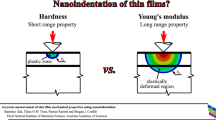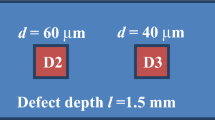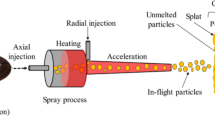Abstract
Infra-red video sequences were taken of directly bonded silicon wafer pairs undergoing the razor blade crack length bond strength measurement in a specially designed jig. A series of tests were carried out under controlled atmospheres of nitrogen at various relative humidities. Analysis of the video images showed that the crack continues to propagate rapidly for several minutes after the blade has stopped moving, and that the presence of moisture has a strong positive influence on the rate of crack propagation under static loading. A new Maszara protocol is suggested based on modelling crack growth using our experimentally derived constants.















Similar content being viewed by others
References
Bagdahn J, Petzold M (2001) Fatigue of directly wafer-bonded silicon under static and cyclic loading. Microsyst Technol 7(4):175–182. doi:10.1007/s005420000085
Ciccotti M (2009) Stress-corrosion mechanisms in silicate glasses. J Phys D Appl Phys 42(21). doi:10.1088/0022-3727/42/21/214006
Freiman SW, Wiederhorn SM, Mecholsky JJ Jr (2009) Environmentally enhanced fracture of glass: a historical perspective. J Am Ceram Soc 92(7):1371–1382. doi:10.1111/j.1551-2916.2009.03097.x
Gy R (2003) Stress corrosion of silicate glass: a review. J Non-Cryst Solids 316(1):1–11. doi:10.1016/s0022-3093(02)01931-2
Kowal J, Nixon T, Aitken N, Braithwaite NSJ (2009) Surface activation for low temperature wafer fusion bonding by radicals produced in an oxygen discharge. Sens Actuators A 155(1):145–151. doi:10.1016/j.sna.2009.08.018
Martini T, Steinkirchner J, Gösele U (1997) The crack opening method in silicon wafer bonding: how useful is it? J Electrochem Soc 144(1):354–357
Maszara WP, Goetz G, Caviglia A, McKitterick JB (1988) Bonding of silicon wafers for silicon-on-insulator. J Appl Phys 64(10):4943–4950
Takagi H, Maeda R, Suga T (2003) Wafer-scale spontaneous bonding of silicon wafers by argon-beam surface activation at room temperature. Sens Actuators A 105(1):98–102
Thomson R, Hsieh C, Rana V (1971) Lattice trapping of fracture cracks. J Appl Phys 42(8):3154–3160. doi:10.1063/1.1660699
Tong QY, Gösele U (1996) A model of low-temperature wafer bonding and its applications. J Electrochem Soc 143(5):1773–1779
Tong Q-Y, Cha G, Gafiteanu R, Gösele U (1994) Low temperature wafer direct bonding. J Microelectromech Syst 3(1):29–35
Turner KT, Spearing SM (2008) Accurate characterization of wafer bond toughness with the double cantilever specimen. J Appl Phys 103(1). doi:10.1063/1.2828156
Vallin O, Jonsson K, Lindberg U (2005) Adhesion quantification methods for wafer bonding. Mater Sci Eng R: Rep 50(4–5):109–165
Wiederhorn SM, Bolz LH (1970) Stress corrosion and static fatigue of glass. J Am Ceram Soc 53(10):543–548
Acknowledgments
We would like to thank the EPSRC and AML for their support and partnership in this work undertaken as part of a CASE funded studentship.
Author information
Authors and Affiliations
Corresponding author
Rights and permissions
About this article
Cite this article
Masteika, V., Kowal, J., Braitwaite, N.S.J. et al. The effect of atmospheric moisture on crack propagation in the interface between directly bonded silicon wafers. Microsyst Technol 19, 705–712 (2013). https://doi.org/10.1007/s00542-012-1685-8
Received:
Accepted:
Published:
Issue Date:
DOI: https://doi.org/10.1007/s00542-012-1685-8




